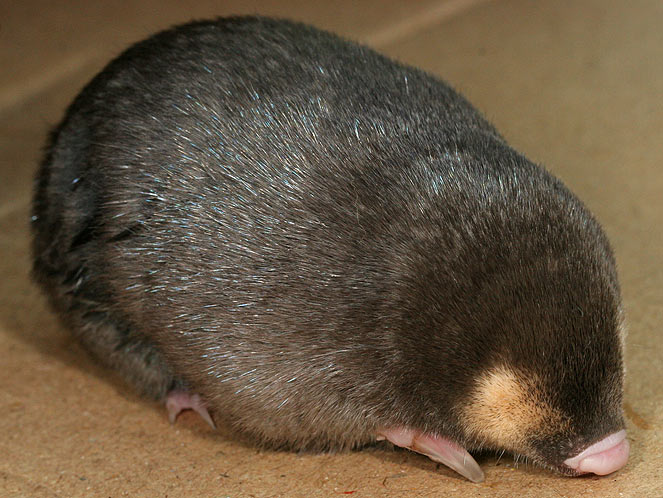|
Chrysochloris
asiatica (Cape golden mole)
Kaapse gouemol, Kaapse kruipmol [Afrikaans]
Life
>
Eukaryotes >
Opisthokonta >
Metazoa (animals) > Bilateria > Deuterostomia >
Chordata > Craniata > Vertebrata (vertebrates) >
Gnathostomata (jawed vertebrates) > Teleostomi (teleost
fish) > Osteichthyes (bony fish) > Class:
Sarcopterygii (lobe-finned fish) > Stegocephalia
(terrestrial vertebrates) > Reptiliomorpha > Amniota >
Synapsida (mammal-like reptiles) > Therapsida > Theriodontia
> Cynodontia > Mammalia (mammals)
> Placentalia (placental mammals) >
Afrotheria >
Afrosoricida > Family:
Chrysochloridae (golden moles) > Subfamily: Chrysochlorinae
 |
|
Cape golden mole, Cape Town, Western Cape, South
Africa.
[photo Hamish Robertson, Iziko ©] |
Identification
The common name of the golden mole is derived
from the characteristic iridescent sheen of the rich fur of the
animal. They are specially adapted for a burrowing mode of life.
Their bodies are compact and streamlined, a without external ear
pinnae and no visible tail. The head is wedge-shaped and the skin is
thick and tough. The minute eyes have almost been lost and are
covered with skin. A leathery pad on the snout that aids with soil
excavations protects the nostrils. The ear ossicles are very large,
providing great sensitivity to vibrations in the surrounding soil,
both for the detection of food and approaching danger. The golden moles are not related to mole-rats.
The latter are herbivorous rodents and have small, visible eyes,
short tails and massively developed chisel-like incisor teeth. The
Golden moles have small pointed teeth, typical of an insectivore.
The muscular head and shoulders push and pack
the soil and the strong forelimbs have large claws for digging.
Three of the four digits have elongated claws with the third being
particularly powerful.
Size
Body Length 11 cm; weight range up to 50 g.
Distribution and habitat
The Cape golden mole occurs in the southwestern Cape, extending
along the coastal plain up the West Coast. Commonly encountered in
Cape Town gardens with sandy soils where their burrowing just below the ground leaves
a path of broken, raised soil. Sometimes fall into swimming pools.
General behaviour
Golden moles are solitary each maintaining
their own burrow system. They burrow just below the soil surface
forming ridges, these are thought to be for foraging. These surface
runs gives rise to one of their popular names amongst the gardening
fraternity - “runner moles”. They also excavate deeper permanent
burrows as refuges and for nesting where the excess soil is
deposited on the surface as molehills.
Food
Feed on insects and other invertebrates, e.g.
earthworms and millipedes.
Conservation
When they occur in gardens they are usually
regarded as a nuisance because they disturb the soil and
occasionally undermine plants. In fact, they are valuable allies as
they eat large quantities of harmful insects and other
invertebrates. Golden moles appear to be common throughout their
distribution and their conservation status is evaluated to have a
low risk of extinction.
|
